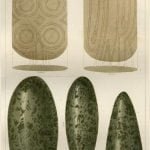
It is known that in skinning an animal, there will always remain some parts of the flesh and integuments to the skin. With a hunter, the operation of skinning is often done in haste, and when there is ever so much leisure, still the fear of cutting the skin, induces the flayer rather to infringe upon the carcass than endanger the value of the hide.
In the hunter state of society, it becomes the duty of the women to dress and prepare the skins taken in the chase. For this purpose, the skins are stretched in the green state on a frame, and the flesh and integuments are cleanly removed. This was done in the early times, by means of an instrument of stone, which has often been mistaken for a small axe. It is a species of hand chisel, blunt that it may not cut the skin, and yet of sufficient edge and hardness to permit a stout jerking blow. It was grasped firmly by the top. It required no crease, as if to bind it. It was often very rude, and presented nothing but an elongated stone, small, and brought to a blunt edge.

By this means, the skin of the deer and other animals was completely rid of its adhering flesh, prior to the process of currying, braining, smoking, or such other processes as it required to fit it for the various uses to which it might be devoted.
Two figures of the instrument are added. Figure 5, Plate 29, was picked up, in 1818, on the Missouri shore, on the high ground above the Chain Rocks. It is a fine porphyry, and exhibits much labor bestowed in rubbing it down. Figure 6 is from the banks of the Ohio, at the Grave Creek Flats. It is a silicious slate.
Another specimen of this instrument is seen in Plate 11, Fig. 4.


